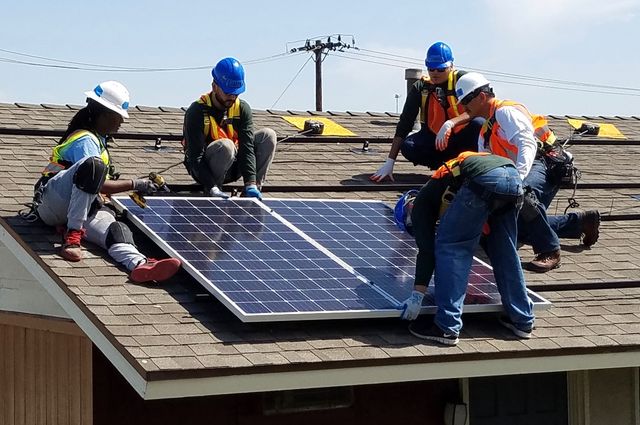Karina Guzman is both property manager and resident of a low-income housing complex for working families in Southern California. Even with the job and relatively affordable rent, Guzman worries about paying her electricity bills. But relief is coming from what she found to be a surprising source: solar panels recently installed on 17 of the 27 buildings in her complex.
The solar panel system will offset the cost of powering lights and other needs in common areas as well as help residents lower their electricity bills. “I can’t wait for the solar panel to help me pay a credit card bill, and maybe even save for a vacation,” Guzman said.
Low-income households typically spend higher percentages of their incomes on energy costs and thus stand to benefit most from utility bill savings due to solar power generated on their homes. Yet, while Los Angeles County is a national leader in the adoption of residential solar, the homes of low-income households account for less than 1 percent of residential solar capacity across the county, according to new research by the UCLA Luskin Center for Innovation and the nonprofit organization GRID Alternatives. This may change.
The study found that cities in Los Angeles County could soon unlock millions of dollars annually in state incentives for residential solar on affordable housing.
Starting in 2018, California will offer a solar rebate program targeted at putting solar panels on the roofs of affordable housing developments. With an annual budget of up to $100 million, the Solar on Multifamily Affordable Housing program “could make a big difference toward reversing the current inequity in the distribution of residential solar systems,” said Michael Kadish, executive director of GRID Alternatives Los Angeles, which makes renewable energy technology and job training accessible to underserved communities.
The program, along with smaller existing state solar rebate programs such as the Low-Income Weatherization Program available for large multifamily residences located in disadvantaged communities across the state, will encourage the installation of solar systems that help affordable housing residents’ reduce their utility bills.
But there is a catch.
Residents of affordable housing and other multifamily dwellings can only take advantage of state solar incentive programs if their utility offers a virtual net metering policy allowing residents to receive credits from the system. Virtual net metering is a common billing mechanism that allows multiple parties to share the financial benefits of a single solar power system.
Southern California Edison offers virtual net metering, but that’s not the case with municipally owned utilities in cities such as Los Angeles, Burbank, Glendale and others in the county. Without virtual net metering, there is no real mechanism for residents of multifamily dwellings, including affordable housing, to access the financial benefits of solar.
“Now is a good time for the city of Los Angeles ― which we identified as having the largest share of rooftop solar potential — 62 megawatts — and rebate-eligible rooftop solar potential in the region ― to consider removing the policy barrier that is currently preventing myriad residents of multifamily dwellings from realizing the benefits of residential solar,” said J.R. DeShazo, director of the UCLA Luskin Center for Innovation and chair of the department of public policy in the UCLA Luskin School of Public Affairs.
After researchers calculated the potential benefits of adding 115 megawatts of rooftop solar power throughout Los Angeles County on the more than 1,100 affordable housing properties that would qualify for a solar rebate, this is what they found:
- $11.6 million annually in utility bill savings for residents in affordable housing
- $4.9 million annually in savings for owners of affordable housing properties
- $220.6 million in funding from state programs to spur local economic development
- 1,800 job years (one year of full-time work or the equivalent) created
- More than 3,800 job training opportunities and nearly 31,000 job training hours that could be strategically targeted to encourage an equitable clean energy workforce
The report includes recommendations for designing a virtual net metering tariff in Los Angeles to help maximize these types of benefits. Findings also highlight the opportunity to target solar workforce development benefits to residents of affordable housing who are more likely to live in communities with higher unemployment rates than the county at large.





